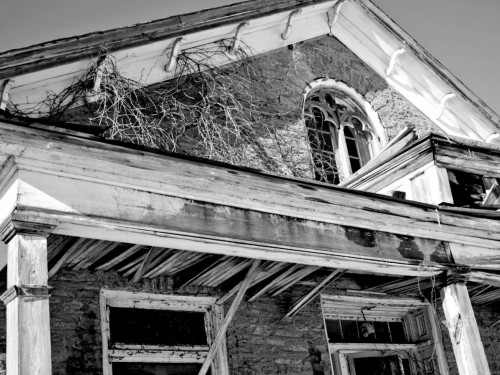County News
Minding history


The Isaac Minaker House in South Bay was partially destroyed by fire. Time and the elements are slowly finishing the job.
Heritage Advisory Committee seeks to restore confidence
Still reeling from a very public dispute over the redevelopment of portion of the Allison Block on Main Street in Picton, the Prince Edward Heritage Advisory Committee (PEHAC) is facing a new challenge to its credibility.
According to County Senior Planner Ryan Leary, the owners of the Waring House had been considering the designation for their 150-year-old property. But the experience of the owners of the Allison Block property has caused Chris and Norah Rogers, owners of the Waring House, to reconsider.
Gordon Parsons is a former member of PEHAC. He is currently advising the Rogers on the designation process. He would only describe it as a “work in progress.”
Leary, however, reported at last week’s PEHAC meeting that an email he received from Parsons stated the couple had pulled back in light of the publicity and news coverage surrounding the Allison Block.
Needless to say, PEHAC Chair Janice Gibbins was upset by the coverage, and the Rogers’ reaction to it.
“That really put us in a bad light, that’s very disturbing,” said Gibbins. “It really rankles me that people don’t know how qualified we are. We are professionals, we are qualified, we are educated, we are experienced. And to be told we’re a bunch of doofuses really rankles me.”
Leary says that fears that owners could lose control over their property are unfounded.
“It’s that misconception that’s out here that you can’t do anything to your properties and we’re going to be throwing a bunch of red tape at you,” said Leary. “That’s just not the case.”
Parsons, along with PEHAC board member Gord Gibbins, hopes to persuade the Waring House owners to come around. In their view, the properties are a part of the County’s heritage and should be protected.
Designating an impeccably restored inn is one thing, but what if the owners of a heritage resource are unable or unwilling to maintain their property?
The Heritage Advisory Committee also considered the issue of the Isaac Minaker House in South Bay. The current owners purchased the property in 1981, and it was designated in 1985.
But a recent fire caused major damage to the once majestic home. The owners say their insurance settlement did not cover the damage caused by the fire. Now it stands wounded by the damage, slowly deteriorating.
Councillor Brian Marisett wanted to know what could be done if a heritage property is damaged, or the owners are physically or financially unable to maintain it.
“We try to keep communication back and forth and give them suggestions, that’s the ideal thing,” explained Leary. “There are options on heritage for council to consider, but they do impose certain requirements on the owners. It’s not a great position to be in politically to say you have repair your house because we want you to repair it but we’re not going to give you the money to do it.”
Leary called such deterioration “demolition by neglect.” Eventually a building that is not maintained will become structurally unsound and need to be torn down despite its cultural value.
Leary did point out that in most cases, the owner of the property wants to maintain it, but the cost is too great. Notably Peter Sage, owner of the Royal Hotel in Picton, is seeking investors and fundraising for the costly restoration of the Main Street building.
Board member Geoff Heinricks suggested that alongside bylaws to maintain heritage property standards, a community group could be put together to do repair work pro bono, or at cost. It would be a way to protect the properties and enable the owners.
“If a property was in trouble we could draw on the community to do something to save it, without adding to the tax bill,” said Heinricks. “I think that it shows that we’re serious but at the same time we’re not putting a burden on the property owners or scaring them silly.”
Currently those are ideas and nothing more. The County has no financial incentive to maintain heritage properties. It brings about many questions— will such a program be effective? Will the community buy into it? And most importantly, would it be seen as another way of taking control out of the hands of property owners?

Comments (0)